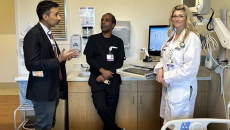Bill Siwicki
Success Stories & ROI
With the EHR technology, the health system achieved a new patient acquisition boost of 19% through its website and has quadrupled its online booking completion rate.
Success Stories & ROI
The new telemedicine site offers extremely short wait times and enables providers to see nearly twice as many patients as they would in the same period for in-person visits. And it beats the overhead and infrastructure costs of a new physical location.
After yet another temporary extension of pandemic-era virtual care flexibilities, a partner at healthcare consulting firm Chartis offers a vision for a sustainable future for these promising care models.
Dr. Eve Cunningham, chief medical officer at telehealth and remote patient monitoring firm Cadence and former virtual care and digital health chief at Providence, sees a way to create a more sustainable and patient-centered healthcare system.
AI & ML Intelligence
Tom Kiesau, chief innovation officer and leader, digital and technology transformation, at healthcare consulting firm Chartis, discusses his vision of AI that includes the aging population, clinical and operational AI, AI operating models and much more.
AI & ML Intelligence
But barely 1 in 10 are properly investing in the infrastructure necessary to support enterprisewide deployments, according to its new research report. An Accenture health analyst unpacks its findings.
AI & ML Intelligence
Once the AI was implemented with several accounts, the tool codified 99% of medications, 85% of sigs and 96% of allergies, Wise's director of operations and finance reports. It's an almost complete prevention of unmatched or invalid medications.
Success Stories & ROI
The 13-hospital network's CDS system also maintained stable patient experience scores – and data validated that cost reduction was achieved without compromising quality of care.
Success Stories & ROI
Sherene Schlegel, RN, chief operating officer and chief nursing officer for virtual care and digital health at the 51-hospital health system, offers a tour of its comprehensive telemedicine offering. She explains the program's evolution and highlights big results.
Robert Slepin, chief digital officer at SE Health and an emeritus CIO adviser at Epic, describes the key aspects of digital transformation that provider organizations need to understand, the primary technologies involved and how to best organize such a comprehensive effort.










